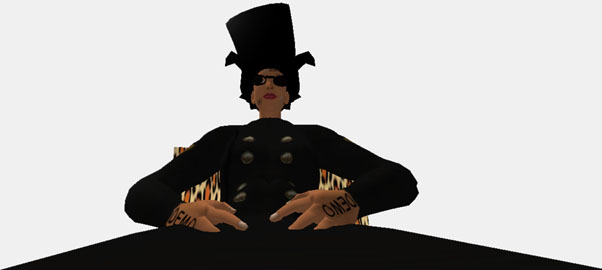

Gazira Babeli
Code Performer
| I know Gaz Babeli |
| Patrick Lichty, January 2008 |
|
"I know Gaz Babeli, Anonymous conversation, attributed to Second Life Chat room... Gazira Babeli is a glitch. In the original Matrix movie, there is a scene when Neo realizes that there is something awry in the system. Déjà vu reveals itself when a black cat moves through the doorway two identical times, signifying the glitch in the system. If Second Life had an analogous "crack" in the OS, there would be a jiggly black top hat wobbling over the transom of the door, with no body in the doorway. Or, you'd turn around to see the woman with the shattered sunglasses and fishnet stockings looking at you as if you just came in on the last interplanetary shuttle from Mars, and what the hell were you doing here... But it's all right, because this is the funhouse, the wilderness of mirrors, and this is to be expected. It's strange being friends with an anomaly. I met Gazira (this is partially mythological, but much of what happens in Second Life is the stuff of myth and hyperbole) while I was building my first SL art center, called the BitFactory in a region called Han Loso. Looking over the 9-story building on the virtual parcel, there was a 100 meter-tall Warholian can of "Second Soup" hovering over the roof, saying "it didn't like me very much", while a school of singing pizzas on the 4th floor were singing "O Sole Mio". This did not cause me dread, like many denizens of Second Life feel for temporary disruption of simulator control, otherwise termed as "griefing", Far from it. I sat back in my chair and became very hopeful. There was a ghost in the machine, and it wanted to play. There was a wall of chaos coming at me with a null set behind it, and that lacuna was Gaz. I have always loved the liminal, the interstitial space between points; the no-one's land between familiar landmarks along the way. This is where, as a writer, curator, artist, theorist, etc. This is the land of the unexpected; and there was Gaz, like a virtual Rumpelstiltskin, spinning gold, building collapsing towers, and throwing nudes down staircases. As I would learn, Gaz would get me thrown off more servers than I could ever imagine, but she would ask me, "Are they ones you really wanted to be on anyway?" This is the question that Gazira asks in her work, "Are we asking the right questions?" Where many SL artists talk of cyborgs, relational aesthetics, displaced signification, networked identity, etc. Gazira's artistic vocabulary is ostensibly Modern. In conversation, strange words that I have not heard much in art circles since the early 80's - "flesh", "blood", "epiphany", "love", "hate", even "faith as argument". These are very strange concepts to be speaking about with an avatar-construct. Gazira is a Barthian "dead author" in that she never references her operator, but her work operates in the human, essential, formal qualities of Modernism. Or rather, Gaz uses a recursive modernism, deconstructing her identity with every work like a set of Matroshka dolls while making no illusions that there the last doll is ostensibly empty; a dead end at the end of Carroll's rabbit hole. As such, I believe that she is a� a sort of "critical readymade", slamming Duchamp through Nauman's lens of life-as-art, and expressing it as a living, breathing body of code. But it is this idea of the living, breathing code-body that seems to express itself when you engage Gaz; her avatar or works are merely expressions of the same "ghost" that her empty signifier represents. To paraphrase Captain Kirk from the Star Trek movies, Gaz "... was the most ... human." Avatar-'hole' I have ever met. Again, this might sound anachronistically Modern for a critic to be speaking of in the 2000's, but Gaz may represent a post-millennial syncretism in media arts. Gazira is a deconstructed artist-construct that still courses with red-hot blood, joy, and pain, epiphanies and despairs. She "griefs" my aesthetic and critical assumptions, and in a way it feels like there is flesh growing back around the machines of intellectual abstraction. Gaz reminds one that, despite all the critical tools at out disposal, that the practice of art, even though it is in the rarefied milieu of a virtual world like Second Life, is a human enterprise. Or, perhaps better yet, a humane one. Gazira is a glitch. And from that glitch comes miracles, like reconstructing towers, aggressive soup cans, and singing pizzas. And as I look up into the virtual sky, here comes the rain of Super Marios from above, like an epiphany of angels, joyfully dancing around me, bouncing, spinning... But another definition of epiphany is "a manifestation of a divine or supernatural being", and I think this describes Gazira perfectly. That's it - Gaz is an epiphany. And I'm in heaven. |
Back to TEXTS |
